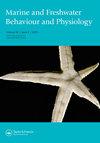饲料对双翅片足类Platorchestia platensis吸氧速率的影响
IF 0.9
4区 生物学
Q3 MARINE & FRESHWATER BIOLOGY
Marine and Freshwater Behaviour and Physiology
Pub Date : 2018-09-03
DOI:10.1080/10236244.2019.1567267
引用次数: 3
摘要
Platorchestia platensis的主要生态环境是河岸上的残骸,但偶尔也会发现该物种生活在腐烂的浮木中并以其为食,作为次要生态环境。以浮木为食的白颡鱼吸氧速率较以残骸为食的低。否定了从浮木向残骸转变饮食后,平腹假体代谢率保持不变的原假设。饮食反转实验表明,平顶对虾的耗氧速率是可逆的,并且是逐渐达到的。这与从残骸到浮木的饮食变化是一致的,反之亦然,导致了平顶扁桃在氧气消耗方面的生理变化,这被描述为驯化而不是适应。本文章由计算机程序翻译,如有差异,请以英文原文为准。
Effect of diet on oxygen uptake rate in the talitrid amphipod Platorchestia platensis
ABSTRACT The primary ecotope for Platorchestia platensis is supralittoral wrack, but occasionally this species may be found living in, and feeding on, rotting driftwood as a secondary ecotope. Lower oxygen uptake rates were measured for driftwood-fed compared with wrack-fed P. platensis. The null hypothesis that the metabolic rate in P. platensis would remain unchanged after reversing the diet from driftwood to wrack was rejected. Diet reversal experiments demonstrated that the oxygen consumption rates of P. platensis were reversible and gradually attained. This is consistent with the change of diet from wrack to driftwood, or vice versa, causing physiological changes involving oxygen consumption in P. platensis, which are described as acclimation rather than adaptation.
求助全文
通过发布文献求助,成功后即可免费获取论文全文。
去求助
来源期刊

Marine and Freshwater Behaviour and Physiology
生物-海洋与淡水生物学
CiteScore
2.10
自引率
0.00%
发文量
9
审稿时长
>12 weeks
期刊介绍:
Marine and Freshwater Behaviour and Physiology is devoted to the publication of papers covering field and laboratory research into all aspects of the behaviour and physiology of all marine and freshwater animals within the contexts of ecology, evolution and conservation.
As the living resources of the world’s oceans, rivers and lakes are attracting increasing attention as food sources for humans and for their role in global ecology, the journal will also publish the results of research in the areas of fisheries biology and technology where the behaviour and physiology described have clear links to the contexts mentioned above.
The journal will accept for publication Research Articles, Reviews, Rapid Communications and Technical Notes (see Instructions for authors for details). In addition, Editorials, Opinions and Book Reviews (invited and suggested) will also occasionally be published. Suggestions to the Editor-In-Chief for Special Issues are encouraged and will be considered on an ad hoc basis.
With the goal of supporting early career researchers, the journal particularly invites submissions from graduate students and post-doctoral researchers. In addition to recognising the time constraints and logistical limitations their research often faces, and their particular need for a prompt review process, accepted articles by such researchers will be given prominence within the journal (see Instructions for authors for details).
 求助内容:
求助内容: 应助结果提醒方式:
应助结果提醒方式:


